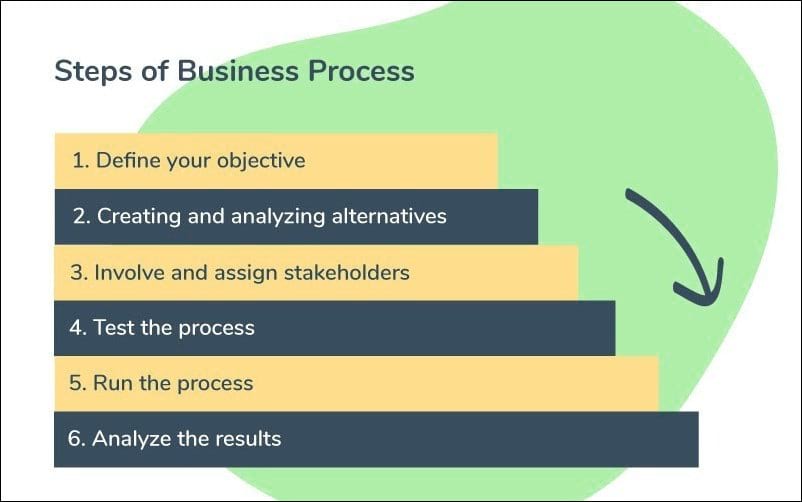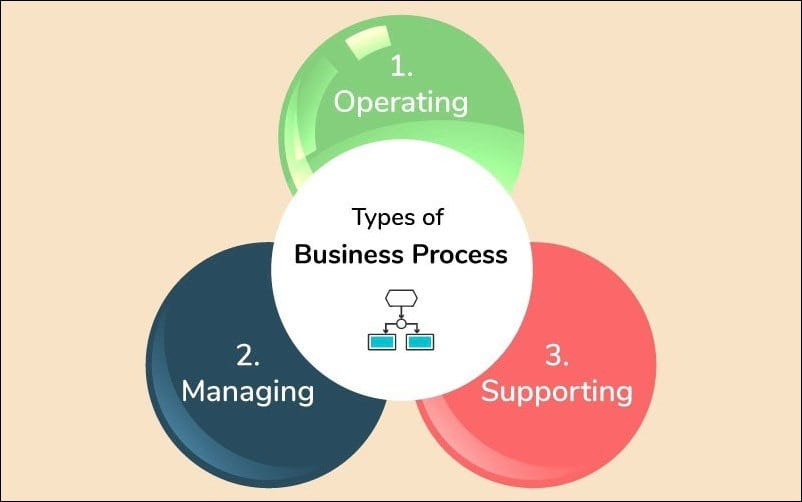From your neighborhood bakery to Google headquarters, there is one thing that remains common in every business. Processes. Each task of every department of every company in the world has a process attached to it. That is why it becomes important for you to know what is the business process.
Business Processes are the set of related tasks necessary to be completed in a chronology to get work done. This topic is far more interesting than a bunch of flow charts and technical visual charts. There are so many things that you can learn about your own business just by looking at your daily processes.
Short on time? Jump around any section
What is Business Process?
Business Process is a set of tasks that directly or indirectly help your business provide the products/services to the customer. Processes are the core of any business. Everyday productivity of employees and long term growth of the business is determined by how well you have managed your business processes.
Why are business processes important?
When you know your business processes and are able to put them into practice, you will see a considerable difference in the amount of work you do. Here are a few reasons why knowing and implementing your business process is essential.
1. It saves time
The aphorism ‘Time is money’ is being used since ages and is still relevant. When your business processes are aligned and crystal clear, you can save a lot of time for your employees and customers. Time is precious for the customers, and when you are able to deliver your promises in time, you increase customer satisfaction. Acquiring customers is 5-25X more expensive than retaining current customers. So it would save you money if you keep customer satisfaction as your top priority. It also boosts the productivity of the people in your business. Let’s say you create a process of onboarding new employees. Now the HR won’t have to manually find missing pieces every time a new employee joins the company. This will save the time of both HR and the new employee.
2. Reduces Opportunity cost
Opportunity cost is the benefit you lose when you choose to do one thing instead of its alternative. We all can’t be like Schrodinger’s cat, living in multiple realities at the same time. That’s why if you save your time in doing one thing, you can utilize it by doing the other stuff. This is how business processes are essential to reduce the opportunity cost. If your HR is not busy with the onboarding of the new employee, they can work on something more productive.
3. Increases the efficiency
Processes will increase the clarity of work in your business. An increase in efficiency is another advantage attached to it. When everyone in the organization knows what they are supposed to do chronologically, it decreases a lot of redundancies and increases the efficiency of the whole organization.
Steps of creating an effective Business Process

There are a few steps in business processes. There is no one standard rule that you need to follow these steps, but we have developed these after analyzing some theories and our business processes.
1. Define your objective
Just like any other process, business processes also need you to be clear about what outcomes you want to achieve. This would help you create the base of your process and give it a suitable direction. Attach some quantitative metrics to your objective, so that you can find out the results after implementation.
E.g., Let’s assume you have a courier business, and you want to prepare a business process for your delivery guys. Your objective might be to decrease the traveling time by 30 mins of each of your delivery guys. You must define this objective and take all the further steps to achieve this objective.
2. Creating and analyzing alternatives
Once you have defined what exactly you want as an outcome, half of the problem is solved. Now you need to create all the alternatives that you can come up with. There will be an opportunity loss attached to each of these alternatives. The task is to find the most suitable option with the least opportunity cost.
E.g., There are multiple solutions to decrease the traveling time of your delivery boys like dividing them into shifts, giving them skateboards, setting their routes in a way they don’t need to detour, but only a few of them will be suitable and feasible. Choose the best out of all of them.
3. Involve and assign stakeholders
This is one of the most critical steps in creating a business process. Once you have designed the process out of all the alternatives, you must involve everyone and make them understand the process. They are directly involved in the running of the process. That is why it is necessary that they understand all the aspects of the process. This would help you save time in the longer run.
4. Test the process
After the process is entirely designed, you must run it on a smaller scale. The practical experience would help you find the gaps that you missed while creating the process. You can fill these small gaps with solutions and make your process official.
5. Run the process
After filling out all the gaps and solving all the minute inconveniences, you should implement the process to your business. Since the stakeholders of the processes know about it, the chances of discrepancies will be reduced to a minimal.
6. Analyze the results
When you designed the process, you had an objective in your mind. Now that you have implemented it, have you been able to achieve the results that you were planning to get? You need to draw a comparison between the earlier process and the current one. The quantitative metric would help you with that.
E.g., You can compare the time taken by your delivery man before and after the implementation of the process. This would give you an idea of whether you were able to achieve the desired results or not.
If the results are achieved, you are good to go. The process that you have created is working effectively. If they are not, you need to change something, either make your objectives more achievable or make your process more efficient. In short, go for the optimizing the business process. With enough trials and errors, you will be able to achieve optimum results.
Examples of Business Process
Here is a simplified example of how Business Process looks like.
1. Industry: Marketing
Company type: Ad agency
Process: Ad creation
Marketing agency processes can be a bit tricky as there is more qualitative output to be delivered. Here are the steps of an ad creation process:
- Understanding client requirements
- Brainstorming idea for the ad
- Preparing a campaign
- Pitching the idea to the client
- Getting the approval
- Making necessary changes
- Providing the deliverables
2. Industry: Information Technology
Company type: SaaS tool
Process: Developing the product
SaaS industry is booming and the solutions provided by these companies are value and utility-driven. Here’s how the process of developing the product looks like:
- Understanding market demand
- Finalizing a product outline
- Programming the backend
- Coordinate with the designer to program
- The front end and the UX
- Preparing an Onboarding experience
- Testing the product internally
- Solving bugs and errors
- Running a beta test
- Taking feedbacks from the users
- Improve further
Types of Business Process

1. Operating Process
These are the main functions of the business. These processes are directly related to the fundamental values, vision, and mission of the business. They are also known as primary processes. You need to give extra attention to these processes as they are the primary revenue streams of the company. Filling the gaps and adding necessary improvements in these processes is essential. Once you complete the evaluation of these processes, it will have a direct impact on the growth of your business.
E.g., McDonald’s restaurant’s operating process would be taking orders, making food, and serving it to the customers.
2. Managing Process
The processes that plan, organize, coordinate and control all the functions of the business fall under managing processes. These processes are goal-oriented. It includes helping and motivating your team to achieve their targets. These processes also help in forming a direction for the further growth of your business. Regulating day to day tasks, teaching employees how to complete a task effectively, launching a new product, etc. are some of the processes under this category.
E.g., CEOs, managers, and top-level management are generally involved in management processes.
3. Supporting Process
These are the processes that are not directly related to the delivery of the service or product to the customer. But they help the business create an environment where the primary processes can work better. That is where the name “supporting process” comes from. These are the processes under the accounting department, human resource management department, and any other department that supports the main functions of the business.
E.g., Hiring a new employee is a supporting function that helps the business expand.
Let’s take a look at this example of a call center to understand all the types of these processes.
Solving queries of clients on the call is the operating function. Managing the whole staff falls under managing processes. While the IT department assisting the employees at the time of any technical or hardware problems will be a supporting process.
Problems while implementing business processes
-
Cross-functional Issues
When two or more functions of a business are involved in the same process, it might lead to some discrepancies. If the discrepancies are not resolved on time, it can become a conflict that could hinder the workflow of your business. Make sure you design your process in such a way that authority and responsibility across the business are balanced, and workflow remains smooth.
-
Distribution of work
This is another most common problem that businesses face every day. Lack of effectiveness in the distribution of work slows down the processes. These bottlenecks are introduced when one person is piled up with a lot of tasks, and the other’s queue is empty. This also introduces stress and discouragement. This is why it is extremely important to design a process after keeping all the stakeholders in mind.
-
Unavailability
Manual activities in the process have a strong dependency on the availability of a person. Often the process does not move forward because the person is busy, ignorant, on-vacation, or they have not prioritized tasks. These problems can get serious after a certain point and have the ability to slow down your business. You can tackle all these problems if you get the right tools on your hand. Process automation tools will help you create and implement processes effectively.
Keeping in mind such business process problems, we introduce you to Fasproc. It is a fast process automation tool that will help you create and implement processes within minutes. We are planning to launch it soon. Be the first out of many more customers to come by joining our beta list. We ensure that you will get great little free gifts from our side, along with the ability to create processes in minutes.
Conclusion
When you start a business, it is important to create, understand, and implement the processes regardless of the scale of your business. Now that you have an idea of how to create and map out these processes, start working on it. If you have any questions or suggestions on how to improve the business processes, let us know in the comments


Trackbacks/Pingbacks